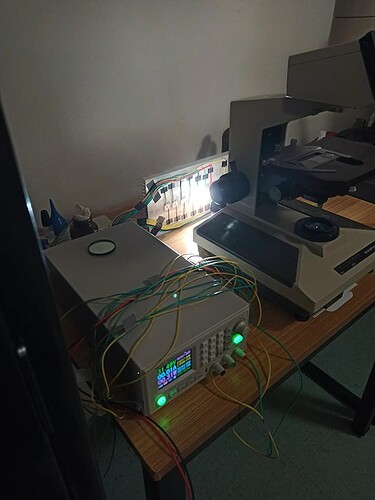I used a bench power supply - you can find them on Amazon or Aliexpress in any voltage/amperage rating a microscope light would require. This allows me to swap to different LEDs / LED arrays at my preference, using the same power supply.
I purchased one capable of 60V & 12A (Riden RD6012) since this would also allow me to power the BHS’ original halogen bulb from the bench power supply if I desired. Since it’s a switching power supply it has switching noise - you may want a linear power supply for less noise. They are 2x+ as expensive though.
Currently I use an array of Nichia E21A MCPCBs simply hot glued to simple aluminum heatsink roughly 12 inches by 6 inches (with thermal paste between.) Don’t worry about thermals, I’ve never had a problem there. You can acquire any desired color temperature by blending the correct mix of E21A emitters on an MCPCB. For blood stains I use an MCPCB covered with Nichia 219B SW45K R9080 emitters, because they are particularly pinkish in color, which is the one color you cannot get with E21As.
You can order MCPCBs pre-soldered with LEDs of your choice, from various amateur resellers (budgetlightforums and candlepowerforums are good resources to look at.) Or, you can buy bare MCPCBs for your specific LED’s footprint, and flow the desired emitters onto them yourself using solder paste and a heat gun, stove, or cigarette lighter. A good term to type into google is “Star PCB LED high CRI”
If you don’t want to bother with MCPCBs you can buy COB emitters. Sunlike and Bridgelux produce the highest-CRI COBs, but they are not quite as high CRI as smaller LEDs. An advantage of these giant COBs is you don’t have to worry about their focal plane very much.
This type setup is definitely superior to the original halogen, especially for high magnification darkfield with the oil condenser. It gives unprecedented control over the light entering the microscope. I can choose any color temperature, and any light intensity, which zero tradeoff between one and the other. I can use a reddish-tinted high-CRI set of LEDs (eg. nichia 219B) for examining blood. Really makes me wonder why modern microscope manufacturers don’t create more sophisticated lighting systems with multiple emitters like this.
Edit: btw, you should probably aim for 4000K or at the most 5000K color temperature, if not lower. Halogen is 5700K but most people use a filter that reduces it to more like 3000K anyway.
In LEDs, lower color temperatures (especially 4000K and below) have much less of a dip in the red color zones (r9 / r13) which are important for blood viewing. It’s also less blue and less harsh on the eyes for long viewing. 4000K is the golden zone imo. If you’re in an experimenting mood, you can de-dome existing LEDs to lower their color temperature in some cases.
Here’s an old pic from when I first started messing about with LEDs.
You can do all kinds of silly things like set paper specimens on fire, if you’re not careful.

